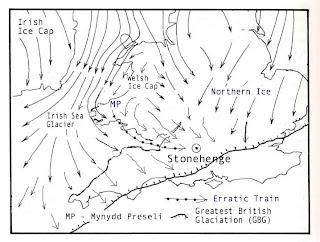The Llan ruined Neolithic burial chamber (in Lampeter Velfrey parish) has been discussed recently on one of the geology Facebook pages, and one of the visitors to the site remarked on the inclusion of at least two large spotted dolerite boulders that were probably used as uprights.
OS Eastings: 214714
OS Northings: 214048
OS Grid: SN147140
https://ancientmonuments.uk/130216-llan-burial-chamber-lampeter-velfrey?
In Barker's 1989 thesis -- p 119 -- there is a mention of a scatter of stones in a field, and reference is made to the debate about whether there were two or even three burial chambers here in a cluster. That would make this a rather important site -- but nothing much is left of the stones, so the Llan is referred to as a "damaged burial chamber site" or as a "lost" site........
There are ten stones in the scatter, including three that are made of a coarse Devonian or maybe Cambrian (?) conglomerate. The biggest stone (probably a fallen capstone) is almost 3m long.REASSESSMENT OF THE NEOLITHIC CHAMBERED TOMBS OF SOUTH-WEST WALES (CARMARTHENSHIRE AND PEMBROKESHIRE)
by Christopher Thompson Barker
This all reminded me of the records of spotted dolerite erratic boulders in SE Pembrokeshire, in the Narberth - St Clears area. In the Geological Survey memoirs at least 30 spotted dolerite boulders are recorded, scattered across the landscape. Unless there are undiscovered spotted dolerite sources elsewhere (still a possibility) the erratics are likely to have come from the Cerrig Marchogion - Carn Goedog - Carn Gyfrwy - Carn Meini area -- and this means glacial transport from the N or NNW. This is interesting, because other evidence of erratic trains points to ice movement across this area from the NW or WNW. this is Griffiths's reconstruction:
We have no idea how many times these boulders might have been moved, and all we can do at present is speculate about "composite" ice movements across several glaciations. This was a reconstruction that I published some time ago, showing a junction between Irish Sea ice to the west and Welsh ice to the east.
Further thought is needed! The ice edge is shown here as being "passive" but I think this must be incorrect for the older glaciations, even though it might be approximately right for the LGM. If the Llan erratics show us anything, they show us that the ice on both sides of the contact zone in eastern Pembrokeshire was streaming sufficiently (at some stage) for the ice to be forced southwards in two parallel ice streams. Lionel Jackson and I proposed this many years ago, but I need to pick the idea up again and redraw this map..........
Like all decent hypotheses, this one exists in order to be modified in response to emerging evidence......
=====================
PS. This is more like it -- one of my older maps in which I postulate ice movements for the "Greatest British Glaciation" with an erratic train running along the contact zone between Irish Sea Ice and Welsh ice. Note that here the ice is flowing from NNW to SSE -- this must have been the approx direction of flow for the transport of the Llan spotted dolerite erratics. Note also that the greater part of the erratic train route is in the Bristol Channel, now submerged........ and another section is deeply buried beneath the Holocene sediments of the Somerset Levels.





2 comments:
Here's an analogy between glacial geomorphology and human transport geography: there is an old, old saying, " It'll all come out in the wash". Medieval historians may recall how King John lost some of his treasure whilst ill-advisably trying to cross The Wash back in his day.
We have heard quite often from Brian that there are no doubt glacial erratics from the Preseli "train" under the waters of the Bristol Channel......
There have been assorted reports of people finding some of them -- but none, as far as I know, have been properly identified and provenanced.
Post a Comment